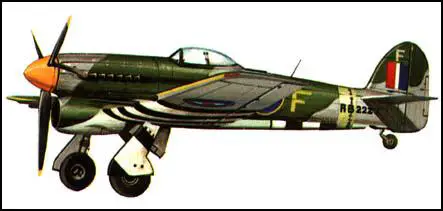Hawker Typhoon
In 1937 the Air Ministry published specifications calling for an interceptor fighter. The Hawker Aircraft Company responded by producing the Typhoon Mk. IB. Powered by a Napier Sabre 24-cylinder, liquid-cooled engine, it had a maximum speed of 412 mph (663 km) and had a range of 980 miles (1,570 km). Armed with four 20 mm cannons it could carry 2,000 lb (907 kg) of bombs. It was 31 ft 11 in (9.73 m) long with a wingspan of 41ft 7 in (12.68 m).
he project to build a jet fighter began in August 1940. Designed by George Carter at the Gloster Aircraft Company, eight prototypes of the Gloster Meteor Mk. I were produced over the next four years. Eventually it was decided to use the turbojet designed by Frank Whittle.
The Gloster Meteor Mk. I had a maximum speed of 415 mph (667 km) and had a range of 1,340 miles (2,156 km). It was 41 ft 3 in (12.58 m) long with a wingspan of 43 ft (13.11 m) and armed with four 20 mm cannons.
The first 20 aircraft were delivered to the Royal Air Force in June 1944. The Gloster Meteor Mk. I saw action for the first time on 27th July, 1944 against the V1 Flying Bomb.
The Gloster Meteor Mk. I first appeared in January 1945 and took part in missions over Nazi Germany. However, by this time the Luftwaffe had been virtually destroyed and it never met the leading German fighters in combat.

Primary Sources
(1) Pierre Clostermann, Flames in the Sky (1957)
With my parachute on my back it took three people to help me up to the Typhoon's cockpit, which is nine feet off the ground. As the plane is very streamlined there is nothing to hang on to. You have to get your fingers in hollows which are covered by metal plates on spring hinges.
They close up again when you removed your hand or your foot, just like a rat trap. In the end they hoisted me up, settled me in, slapped me on the back, shouted 'good luck', and I found myself all alone inside the bowels of the monster.
I rapidly called back to mind all the gen my instructors had given me. As the exhaust gases had a high carbon dioxide content, and seeped into the cockpit, you had to breathe oxygen all the time. I therefore hurriedly put on my mask and opened the intake valve. On take-off Typhoons swing hard right and I therefore adjusted the rudder trim very carefully. I opened the radiator wide. I checked the locking of the undercart-the lever looked uncomfortably like the one for the flaps. I lowered the flaps control to open up the pneumatic circuit in order to avoid ram effect just as I started up.
(2) Edward Lanchbery, Against the Sun (1955)
Neither the Spitfire nor the Hurricane was fast enough to match the new Focke-WuIfe 190 with which the enemy was launching a campaign of tip-and-run raids on coastal towns. Only the Typhoon had the speed.
Although the decision to use the Typhoon before it was ready was ultimately justified by the results, it meant in the beginning that the first Typhoon squadrons were virtually continuing the flight test development of the aircraft with one of the facilities for the job but every disadvantage. The price of the Typhoon's premature introduction to operational service was heavy. During the first nine months the casualty rate from teething troubles was greater by far than that from enemy action, and in the period July to September, 1942, the loss from engine or structural failure of at least one aircraft per sortie occurred on Typhoon wing practices and sweeps over the French coast. Without the tremendous pressure resulting from these accidents, however, it is unlikely that the Typhoon would have developed and been available in adequate numbers to provide one of the finest ground-support aircraft for the invasion of Europe some eighteen months later.
The main consequence of the Typhoon's over-hasty appearance was recurring engine trouble. Emergency landings became an inevitable part of the routine of flying Typhoons; and the prospect particularly of engine trouble over the sea was not a happy one.
